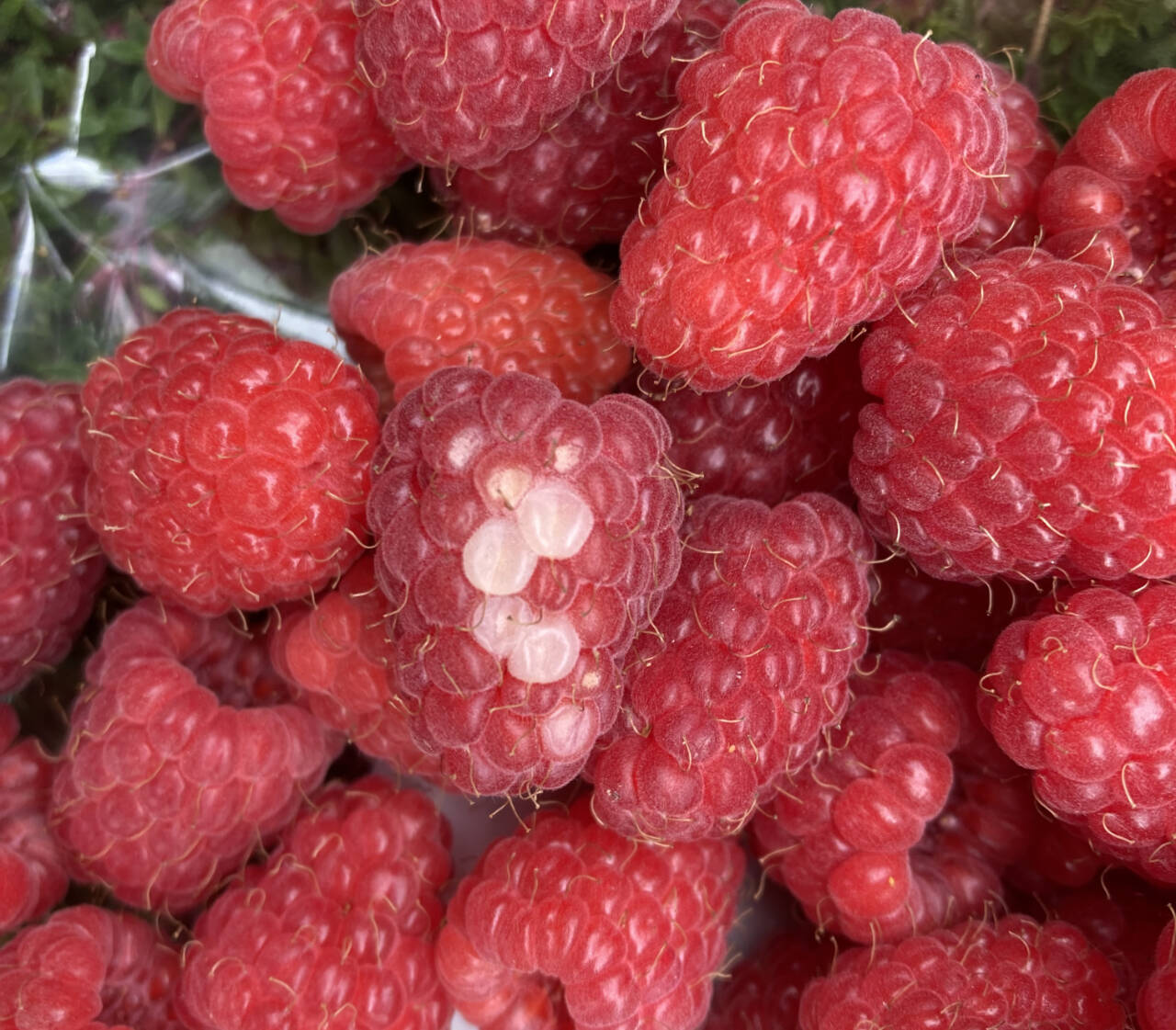What’s wrong with my raspberry bushes? The leaves toward the bottom of several canes have turned yellow and brown in the middle and some of the berries have white spots (see photos).
I think your raspberries are suffering from sunscald, also known as white drupelet disorder. Drupelets are the small fleshy subdivisions that make up a raspberry fruit. Sunscald results from exposure to intense sunlight (excess UV radiation) and high temperatures.
With sunscald, drupelets of affected berries become bleached or tan. The entire sun-exposed side of a berry or scattered drupelets (as in your case) can lose color. Sun-scalded leaves turn yellow, then brown; they often drop prematurely from the bush.
Sunscald is most likely to occur when humid, cloudy days are followed by hot, sunny conditions. Drought can play a role. Leaf manifestations are more commonly seen with recently planted bushes and those grown in containers because their root systems are not as developed as more established plants.
What can you do about sunscald? Harvest the fruit frequently. Sun-scalded fruit is still edible but shrivels with time, becoming hard and unpalatable.
Fertilize and irrigate bushes to encourage good leaf growth that will shade the fruit and protect against sunscald. Apply 2-3 ounces of nitrogen per 10 feet row of raspberries each spring; the total fertilizer weight will depend on the fertilizer formulation and percentage of nitrogen in the product. Apply half when new primocanes (first year canes) start to emerge (usually late March to early April). Apply the other portion one-and-a-half to two months later (late May to early June). Provide 1-1.5 inches of water to your bushes each week.
If sunscald is a major problem in your raspberry patch, you can protect plants with a temporary cover such as a shade cloth during warm sunny weather. Be aware, however, that raspberries need six to eight hours of sun each day for good fruit production and should not be grown in total shade. Early morning and late afternoon sun are less likely to cause sunscald.
Important note: Some sources suggest that spider mite infestations can lead to similar leaf symptoms.
Spider mites usually cause a yellowish stippling or speckling of the leaf as they feed but can cause entire leaves to turn yellow and drop. Spider mite feeding is usually accompanied by webbing on the underside of leaves and between leaves and stems.
To rule out spider mites, use a hand lens to scout for mites on your raspberries. Spider mites will appear as small white to greenish dots on the underside of the leaves. Shake the leaves over a white sheet of paper; if the small dots fall to the paper and move around, they are spider mites.
Hose spider mites from plants with a strong stream of water. Apply insecticidal soaps and horticultural oil to further control this pest.
For more information on spider mites, see hortsense.cahnrs.wsu.edu/fact-sheet/raspberry-spider-mites.
Fragrance adds to the sensory experience of a home garden. Can you recommend plants with a nice fragrance to grow in the Pacific Northwest?
Plants produce floral scents primarily to attract pollinators. Flower fragrance and color help pollinators identify and locate their host plants, increasing pollinator foraging efficiency while allowing for successful pollination of flowers.
In most plants, fragrance results from volatile organic or aromatic compounds produced by floral tissue (e.g., flower petals or stamens). The quality and timing of the fragrance varies with the maturity of the blossom and visitation practices of desired pollinators.
Scent typically is at its maximum when flowers are ready for pollination; it is less intense or even absent in immature flowers and flowers that have already been pollinated. Plants pollinated by bees or butterflies tend to have their most intense fragrance during the day when these insects are active; those pollinated by moths and bats release their fragrance mostly at night. Species pollinated by bees and flies tend to have sweet scents; those pollinated by beetles are said to have strong musty, spicy or fruity odors.
Scented flowers tend to be more fragrant on sunny rather than shady days when the fragrance molecules volatilize more readily and diffuse into the air. Floral scent lingers in areas of high humidity and dissipates more quickly at breezy sites.
Many flowering plants produce inviting scents. (See sidebar for a few ideas.) Be aware that different cultivars of the same species can produce different amounts of fragrance and that fragrance has been bred out of some newer cultivars to lengthen the longevity of the cut flower. If fragrance is important to you, be sure to read the plant description before purchasing a particular cultivar for its fragrance.
Jeanette Stehr-Green is a WSU-certified Clallam County Master Gardener.
Fall, winter berry care
From 10:30 a.m.-noon on Saturday, Aug. 19, veteran Clallam County Master Gardener Jeanette Stehr-Green will discuss fall and winter berry care at the Woodcock Demonstration Garden, 2711 Woodcock Road. She will talk about how to prepare strawberries, raspberries, blackberries and blueberries for the winter and steps that can be taken in fall and winter to maintain plant health.
Plants with fragrant flowers
Bearded iris
Dianthus
Daffodils
Flowering crab apple
Freesia
Heliotrope
Honeysuckle
Hyacinth
Jasmine
Lavender
Lilac
Lily of the valley
Mock orange
Moon flower
Nicotiana
Oregano
Oriental lily
Peony
Phlox
Rose
Sweet alyssum
Sweet pea
Thyme


